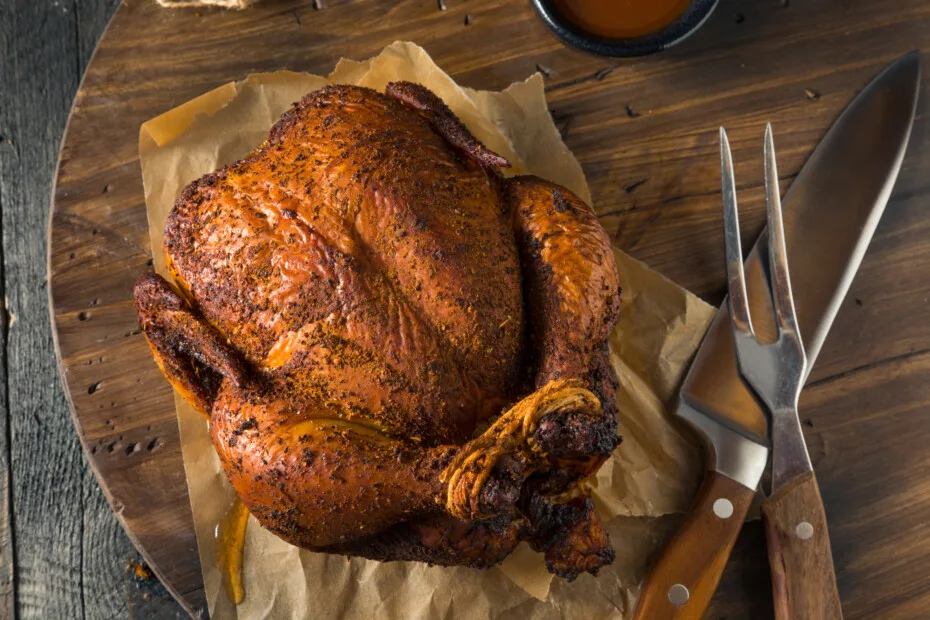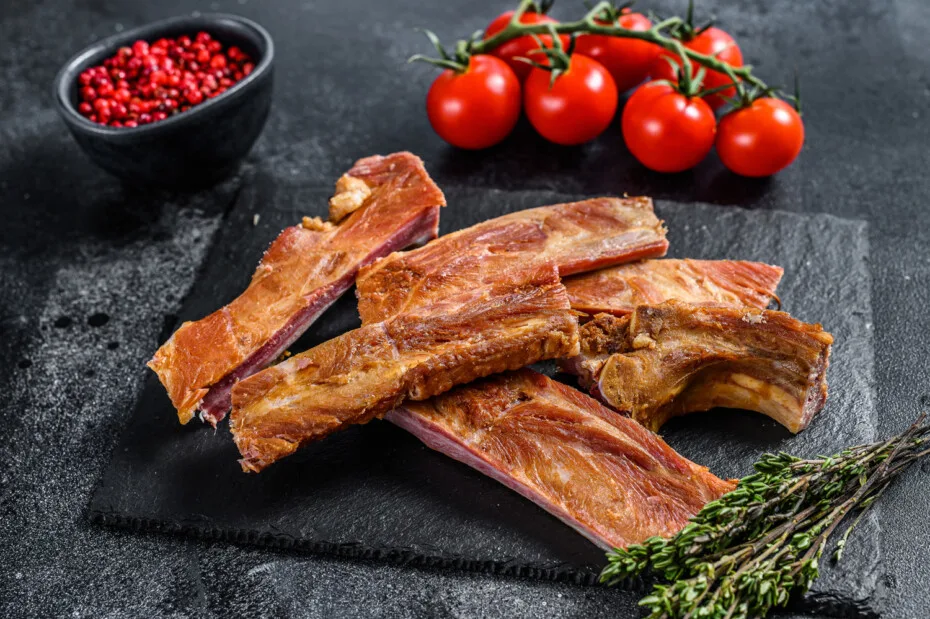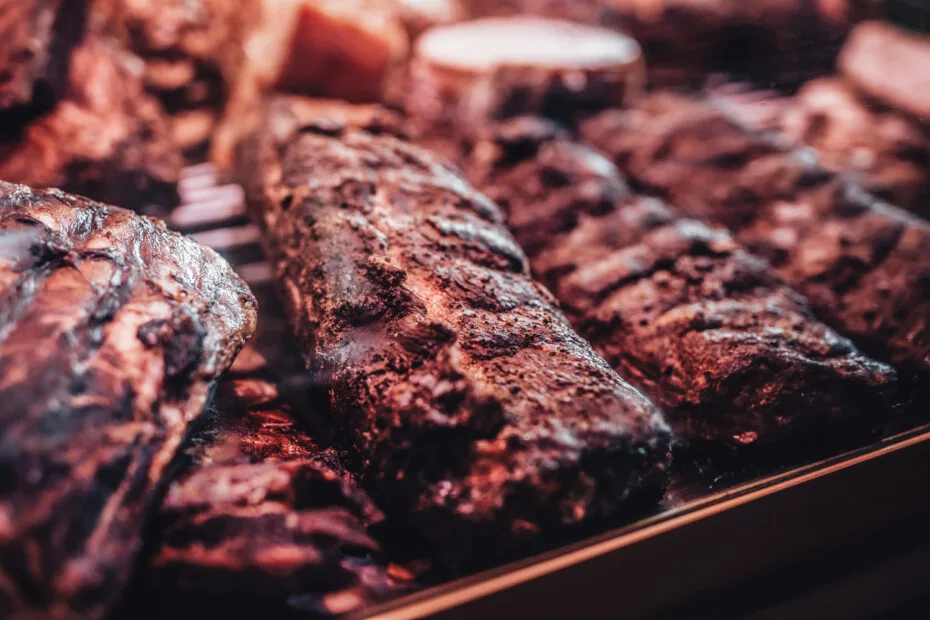No one can dispute that grilling is a great way to prepare flavorful meats. Grilling imparts lovely char-grilled flavor and creates deliciously tender food.
However, smoked meats are just as good if not better than grilled foods.
Unlike grilling, which uses high heat to sear meat on the outside, smoking uses indirect heat to cook foods low and slow.
Though the food requires patience and hours of preparation, smoking meats is undoubtedly worth it as it infuses the meat with a delicious smoky flavor.
Contents
Best Woods To Smoke Meat With
Whether you have a pellet smoker or an offset smoker, it does not matter what kind of smoker you own, as they all require woodchips or pellets to operate.
Wood chips infuse your meats with a smoky flavor. In addition to this, the kinds of wood chips you need will also depend on what you are smoking.
Woods such as maple, cherry, or apple are perfect for turkey, pork, and chicken, while oak is the ideal wood for brisket. Oak is not the best for chicken as it can overpower the flavor of the meat.
Hickory is a popular classic wood that can be used to smoke several types of meat. Nevertheless, it pairs well with pork butt or ribs.
On the other hand, mesquite wood has a robustly smoky flavor that is better suited to open-air smoking or dark meats.
In addition to this, cedar is best used to smoke fatty fish since it imparts an extremely strong flavor.
Meat Smoking Temperatures
The ideal temperature for smoking meats is 200°F-225°F. Furthermore, the internal temperature for smoked red meats should be 145F°, while the internal temperature for smoked poultry is 165°F.
In contrast, ribs and brisket are finished cooking when they attain a temperature of 145°F.
However, most BBQ experts recommend allowing these meats to come to an internal temperature of 180°F or higher to increase the chances that your meats will be perfectly tender.
Tips for Smoking Meats
Smoking meats requires patience to achieve the best results. There’s no point in rushing through the smoking process only to end up with a subpar brisket or chuck roast.
Give your meat enough time to allow its connective tissue time to dissolve to create a tender, delicious piece of smoked meat.
In addition to this, more smoke is not necessarily better for smoked meats. Most people assume more smoke equals more flavor; however, this is not true.
Sometimes the quality of the meat is better than the quantity of smoke.
For example, thick clouds of smoke can be produced by oxidization. This oxidation imparts a bitter flavor to your meats.
Most experts recommend producing thin clods of smoke to allow your meats to absorb the right amount of smoke.
Humidity plays a critical role in the smoking process. As the meat’s temperature increases, moisture is lost and drips off the surface of the meat.
Using a water tray prevents the smoker’s cooking chamber from becoming humid, inhibiting evaporative cooling.
In the end, the water tray not only gives you moister meat but it decreases the smoking time.
Whether you are smoking pork shoulder or chuck roast, always keep your smoker’s lid or door closed.
Opening the smoker’s lid excessively results in temperature changes which ultimately lengthens the smoking time of your meats.
Allowing your meat to rest is an essential part of the smoking process.
Though it means you will have to wait a little longer to taste the fruits of your labor, it is worth it.
Letting your brisket rest allows the juices to reabsorb into the meat and guarantees you will have a tender cut of meat.
Best Meats to Smoke
While you can technically smoke any meat, there are just some meats you should never smoke.
Luckily you can avoid smoking unsmokeable meats since you have this list at your disposal.
Beef Brisket
Brisket is the ideal candidate for smoking. Most BBQ experts will agree that brisket is one of the best and most delicious meats to smoke.
When cooked properly, beef brisket is delectably tender and flavorful.
It takes approximately 10-14 hours to smoke meat in a smoker. However, the smoking time will depend on the size and thickness of your brisket.
Nevertheless, you want to make sure your brisket achieves a temperature of 195°F before removing it from the smoker and eating it.
In addition to this, the type of wood chips you use to cook your brisket will be absorbed into the meat.
This means if you wanted to experiment to find the best wood or a combination of wood chips that create the perfect flavor, you can.
Once you add your brisket to the smoker, do not constantly open the smoker to monitor its progress.
It will jeopardize the smoke as well as the smoker’s internal temperature.

Whole Chicken
Whether you are a newcomer to the world, smoking, or prefer meat that cooks faster than a 10-14 hour brisket, smoking a whole chicken is always an excellent idea.
Chicken is ideal for novice smokers because it cooks quickly and remains moist during the smoking process.
Furthermore, smoking a whole chicken will take about 35-45 minutes per pound, a relatively short time.
The ideal temperature to smoke a chicken ranges between 220°F-225°F. Depending on your smoker’s size, you can also smoke two whole chickens simultaneously.
Ensure that your smoked chicken’s internal temperature ranges between 160°F-165°F before removing the chickens from the smoker.
Tint your birds with foil and allow them to rest before carving and serving your whole smoked chicken.
Pork Butt or Shoulder
Even though the name implies it, pork butt is not the rare end of the pig. It is fabricated from the upper shoulder region of the animal’s front legs.
The pork shoulder is the lower segment of the shoulder that is closer to the elbow.
Pork butt and shoulder are fairly large cuts of meat, making them the ideal meat to smoke if you are feeding a large group of people.
Nevertheless, it is important to note that these cuts can take 10 hours or more to smoke because they are so large.
If you purchased a bone-in pork butt, a tell-tale sign it is finished cooking is when the bone slides out easily when it’s twisted gently.
If you purchased a boneless pork butt, make sure it has an internal temperature of 160°F before removing it from the smoker. The ideal temperature for a smoked pork shoulder is 205°F.
Beef Oyster Blade
The beef oyster blade is an excellent candidate for smoking. The meat is already versatile as it can be used for many dishes.
However, smoking it will add irresistible flavor to tacos, quesadillas, sandwiches, stir-fries, and meat pies. You can also eat smoked beef oyster blades as a stand-alone dish.
One of the best things about smoking this cut is its long cooking time. You can place your oyster blade into your smoker and walk away.
It is best to season your beef oyster blade at least 24 hours in advance and preheat your smoker to 280°F.
Check the progress of your beef oyster blade after 3 hours, then consecutively every hour until it has a temperature between 205°F-210°F.
Let your beef oyster blade rest for 30 minutes to an hour before shredding or pulling the meat and serving it.
Chicken Leg Quarters
Like whole chicken, smoked chicken leg quarters are also a delicious crowd-pleasing dish. It is also perfect for novice smokers who are not up to the challenge of smoking an entire chicken.
Additionally, you can also cut a whole chicken into quarters and smoke it.
Leg quarters will typically take about 1 hour and 30 minutes to cook completely. However, make sure they have an internal temperature of 165°F before removing them from the smoker.
You may notice a pink ring develops around your chicken. However, this does not mean it has not been cooked thoroughly.
The pink rink is a common sight on smoked chicken so use a temperature to gauge the doneness of your chicken.
Lamb Shank
Lamb shanks can also be smoked. You can smoke your lamb shanks using one of two methods.
You can place them into a pot with your preferred seasonings, herbs, vegetables, and liquid, cover the pot, and braise the lamb shanks for 3-4 hours at a temperature of 375°F.
Braising lamb shanks in a smoker results in a tender lamb shank with subtle tones of smoky flavor.
In contrast, you can also smoke your lamb shanks using your smoker’s lowest temperature setting for 3-4 hours until they are tender.
Smoking lamb shanks using this method is best if you want your lamb shanks to have a pronounced smoky flavor.
Beef Cheeks
If you prefer tender meat that gives you a melt-in-the-mouth feel, smoked beef cheeks are the ideal smoked meat.
Beef cheeks are riddled with high levels of intramuscular fat, which makes them the perfect meat to be cooked using a low and slow temperature in a smoker.
First, begin by smoking your beef cheeks on your smoker’s lowest setting for a minimum of 30 minutes. This allows your beef cheeks to develop a rich smoke ring.
In addition to this, the beef cheeks will also absorb the smoky flavor of your beef cheeks.
Increase your smoker’s temperature to 300°F and smoke your beef cheeks for an additional 2-3 hours before braising them in your preferred liquid along with vegetables and herbs for an additional 2-3 hours.
Once the beef cheeks have an internal temperature of 205°F, they are finished cooking.
Pork Ribs

Pork ribs are always an excellent choice for smoking.
While your options may be limited between baby back ribs and spare ribs, the end result will yield tender ribs unfused with a delicious smoky flavor.
As the name implies, baby back ribs are the smaller version of the two and are fabricated from the animal’s back.
In contrast, spare ribs are larger and carved from the animal’s sides near the belly.
Even though these differences seem vast, the smoking process for both baby back ribs and spare ribs is bearly identical. On average, one rack of ribs will take approximately 4-6 hours to smoke.
The bones found in ribs make it difficult to identify the meat’s internal temperature.
You should aim your thermometer in between the bones rather than on the bones.
Alternatively, you can also pierce the meat with a skewer. If the skewer slides through the meat with ease, your ribs are finished cooking.
Smoked Chuck Roast
Chuck roast is the perfect substitute for those that love briskets but do not want to spend all day lounging around waiting for their brisket to finish cooking.
However, its rich marbling makes it the ideal meat for smoking.
While the chuck roasts are cooking in the smoker, the fat and connective tissues break down, making the meat tender and moist.
Chuck roasts take approximately 5-6 hours to cook completely.
Ideally, you want to have a minimum internal temperature of 160°F.
However, if you prefer a medium chuck roast, aim for an internal temperature of 190°F or 200°F for well done.
Smoked Lamb Shoulder
Like pork shoulder, lamb shoulder is also an excellent candidate for smoking.
The results closely resemble a smoked pork shoulder, and it works as a different option for those that do not eat pork.
Preheat your smoker to 300°F, then add your lamb smoker and cook it until it has an internal temperature of 200°F-205°F.
Wrap your lamb shoulder with foil after you remove it from the smoker and let it rest for 1 hour before serving.
Smoked Turkey Breast
If you do not want to smoke the entire turkey, turkey breast is the next best thing.
Before you add your turkey breast, cover it with butter and your preferred seasoning, making sure to get all of the seasonings underneath the turkey breast’s skin.
Turkey breasts take approximately two hours to cook completely. Once your smoked turkey breasts have an internal temperature between 162°F-163°F, they are done cooking.
Final Thoughts
Like grilling, smoking is one of the ultimate cooking methods when it comes to meats.
Though it requires time and patience, smoked meats are the best meats. Happy smoking!

I have been smoking and grilling meat from an early age and enjoy sharing my knowledge and expertise through the hundreds of articles I have written about BBQ. I hope to make everyone’s BBQ journey that little bit easier.

